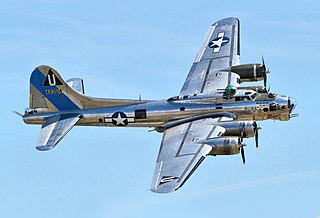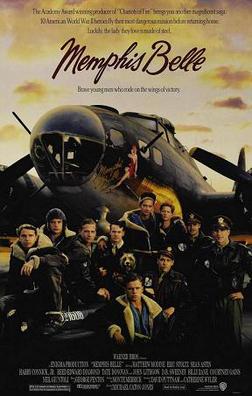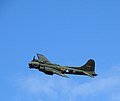
The Boeing B-17 Flying Fortress is an American four-engined heavy bomber aircraft developed in the 1930s for the United States Army Air Corps (USAAC). A fast and high-flying bomber of its era, the B-17 was used primarily in the European Theater of Operations and dropped more bombs than any other aircraft during World War II. It is the third-most produced bomber of all time, behind the American four-engined Consolidated B-24 Liberator and the German multirole, twin-engined Junkers Ju 88. It was also employed as a transport, antisubmarine aircraft, drone controller, and search-and-rescue aircraft.

Imperial War Museum Duxford is a branch of the Imperial War Museum near Duxford in Cambridgeshire, England. Britain's largest aviation museum, Duxford houses the museum's large exhibits, including nearly 200 aircraft, military vehicles, artillery and minor naval vessels in seven main exhibition buildings. The site also provides storage space for the museum's other collections of material such as film, photographs, documents, books and artefacts. The site accommodates several British Army regimental museums, including those of the Parachute Regiment and the Royal Anglian Regiment.

Memphis Belle is a 1990 British-American war drama film directed by Michael Caton-Jones and written by Monte Merrick. The film stars Matthew Modine, Eric Stoltz, and Harry Connick Jr.. Memphis Belle is a fictional version of the 1944 documentary Memphis Belle: A Story of a Flying Fortress by director William Wyler, about the 25th and last mission of an American Boeing B-17 Flying Fortress bomber, the Memphis Belle, based in England during World War II. The 1990 version was co-produced by David Puttnam and Wyler's daughter Catherine and dedicated to her father. The film closes with a dedication to all airmen, friend or foe, who fought in the skies above Europe during World War II.

Liberty Belle was a popular name for United States Army Air Forces (USAAF) aircraft during World War II; over two dozen known individual Boeing B-17 Flying Fortresses and Consolidated B-24 Liberators used the name.

|}

The Pink Lady is the nickname of a B-17G Flying Fortress bomber, serial number 44-8846, which flew several missions for the United States Army Air Forces (USAAF) over Nazi Germany near the end of World War II. The plane is now on static display in Cerny, Essonne, France.

Duxford Aerodrome is located 8 nautical miles south of Cambridge, within the civil parish of Duxford, Cambridgeshire, England and nearly 1-mile (1.6 km) west of the village. The airfield is owned by the Imperial War Museum (IWM) and is the site of the Imperial War Museum Duxford and the American Air Museum.

The Swoose is a Boeing B-17D-BO Flying Fortress, USAAF serial number 40-3097, that saw extensive use in the Southwest Pacific theatre of World War II and survived to become the oldest B-17 still intact. It is the only early "shark fin"-tailed B-17 known to exist, and the only surviving B-17 to have seen action in the 1941–42 Philippines Campaign, operating on the first day of the United States entry into the war.

Thunderbird was a high mission-tally Boeing B-17G Flying Fortress of the 303rd Bombardment Group during World War II. The original plane, serial number 42-38050, was scrapped at the end of the war and no longer exists. The name also appears on a later B-17G delivered at the end of the war, serial number 44-85718, which remains airworthy and is painted to replicate the earlier Thunderbird.

Nine-O-Nine was a Boeing B-17G-30-BO Flying Fortress heavy bomber, of the 323d Bombardment Squadron, 91st Bombardment Group, that completed 140 combat missions during World War II, believed to be the Eighth Air Force record for most missions without loss to the crews that flew her. A different B-17G, painted to mimic the Nine-O-Nine, crashed at Bradley International Airport in Windsor Locks, Connecticut, in October 2019.

Shoo Shoo Shoo Baby, originally Shoo Shoo Baby, is a Boeing B-17 Flying Fortress in World War II, preserved and currently in storage at the National Museum of the United States Air Force, awaiting transfer to the Smithsonian's National Air and Space Museum. A B-17G-35-BO, serial number 42-32076, and manufactured by Boeing, it was named by her crew for a song of the same name made popular by The Andrews Sisters, the favorite song of its crew chief T/Sgt. Hank Cordes. Photographs of the bomber indicate that a third "Shoo" was added to the name at some point in May 1944 when the original aircraft commander completed his tour of duty and was replaced by another pilot.

Sentimental Journey (44-83514) is the nickname of a B-17G Flying Fortress bomber. It is based at the Commemorative Air Force Museum in Mesa, Arizona, US. The aircraft is regularly flown to airshows throughout North America.

Aluminum Overcast, B-17G-105-VE, s/n 44-85740, civil registration N5017N, as of August 2024 Aluminum Overcast is not flying. It is in the Eagle Hanger at the Experimental Aircraft Museum in Oshkosh,WI. It is awaiting wing spar repair. Boeing B-17 Flying Fortresses of the 46 complete surviving airframes in existence. It never saw combat, and it escaped the fate of many aircraft that were scrapped after World War II. It is owned by the Experimental Aircraft Association (EAA), and, as of 2022, it is still touring the United States and Canada offering flight experiences.

Texas Raiders was an American Boeing B-17 Flying Fortress, a B-17G-95-DL built by Douglas Long Beach. In 1967, it was purchased by the Commemorative Air Force's Gulf Coast Wing "Texas Raiders" group, which maintained and flew the aircraft out of Conroe-North Houston Regional Airport in Conroe, Texas. The aircraft was destroyed on November 12, 2022, by a mid-air collision with a P-63 Kingcobra at an air show at Dallas Executive Airport, Texas, that killed all five occupants and the P-63 pilot.

Yankee Lady is a Boeing B-17 Flying Fortress, previously owned by the Yankee Air Museum of Van Buren Township, Michigan. Originally delivered to the U.S military in 1945, the plane did not see combat action; it was used by the United States Coast Guard for over a decade. Purchased by the museum in 1986, it has since been restored to a World War II configuration and is flown for flight experience rides and airshow appearances. The aircraft was sold to an unknown party in June 2024.

The 3205th Drone Group is a discontinued United States Air Force unit that operated obsolete aircraft during the 1950s as radio-controlled aerial targets for various tests. It was the primary post-World War II operator of surplus Boeing B-17G Flying Fortress aircraft, and also operated Lockheed F-80 Shooting Star and a few Boeing RB-47 Stratojet bombers that were converted into drone aircraft during the early years of the Cold War. It was last active with the Air Proving Ground Center, based at Eglin Air Force Base, Florida, where it was discontinued on 1 February 1961.

Boeing B-17G Flying Fortress No.44-83690 is a B-17 Flying Fortress heavy bomber currently undergoing restoration at the Museum of Aviation near Robins Air Force Base in Georgia. It was built as a B-17G-95-DL by the Douglas Aircraft Company and delivered for use on May 9, 1945. It was flown to Grissom Air Force Base for display as a museum piece in 1961. The plane was listed on the National Register of Historic Places in 1993. It was moved to the Museum of Aviation in August 2015.























